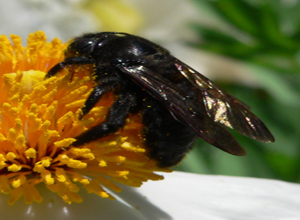The Valley Carpenter Bee, can be nectar robbers. They sometimes “cheat” flowers out of pollination by using their sharp mouthparts to cut a hole near the base of the flower to extract the nectar.
Photo Credit: Calibas via WikipediA
Xylocopa varipuncta
Common Name: valley carpenter bee
Animal Guild: Insect
Class > Order > Family: Insecta > Hymenoptera > Apidae
What does the species look like?
The females are completely black while the males are yellow with green eyes.
Total adult length: 0.7 to 1.0 inches (18 - 26 mm).
Similar species: Bumblebees may look like these Carpenter Bees, but Bumblebees have more fur overall. Carpenter Bees have a bare part on their upper abdomen that appears glossy.
Where is the species found?
States & Provinces
AZ, CA, NM, NV, TX, UT
Distribution
This species occurs in the southwestern United States and into Mexico.
General Phenology and Life History
Males are typically the first to emerge in early spring and feed on nectar and pollen in preparation for mating. Males can exhibit territorial defense to protect their share of female mates in a given area. In late spring, the males have died, and females build their nests. Larval bees develop in their nests over the summer, fall and winter and emerge the following spring.
Which phenophases should I observe?
Do you see/hear...?
Activity
Adults More...
For abundance, enter the number of individual animals observed in this phenophase.
Male adults Xylocopa varipuncta , males are fuzzy and gold in color with green eyes, whereas females are completely black.
For abundance, enter the number of individual animals observed in this phenophase.
Flower visitation For abundance, enter the number of individual animals observed in this phenophase.
Reproduction
Mating For abundance, enter the number of individual animals observed in this phenophase.
Nest building For abundance, enter the number of individual animals observed in this phenophase.
Nest provisioning Xylocopa varipuncta , pollen is carried between hairs on the hind legs and looks like bright yellow, orange or white "fuzz".
For abundance, enter the number of individual animals observed in this phenophase.
Development
Dead adults For abundance, enter the number of individual animals observed in this phenophase.
Method
Individuals in a trap For abundance, enter the number of individual animals observed in this phenophase.
What do these phenophases look like?
The following Phenophase Photo Guides for this species have been vetted for accuracy by the USA-NPN National Coordinating Office. Most photo guides are developed for a particular local or regional monitoring effort, and some of the content may not apply to your effort or your region. However, we make them available to provide as much help as they may in illustrating phenophases for this species. If you have high quality phenophase photos that you are willing to share with us, please visit the Phenophase Photo Guidelines page.
Be aware there is variation from individual to individual within a species, especially across different regions, so your plant may not look exactly like the one pictured.
Since they do not always include complete definitions for the species, use these photo guides ONLY in conjunction with the official Nature's Notebook phenophase defintions included in the table above, in the phenophase definition sheet that downloads with the datasheet, or in the Observe screen in the mobile app.
